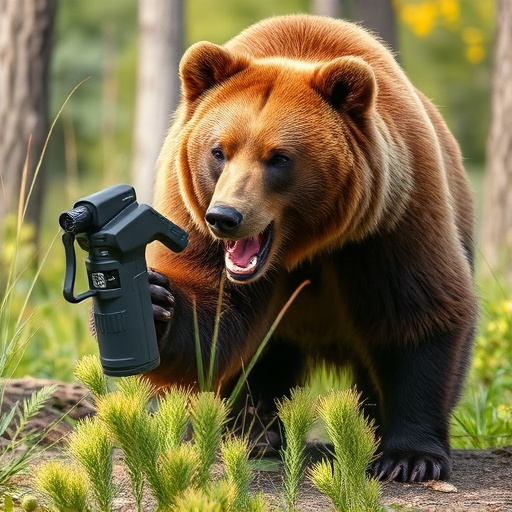Understanding bear behavior and taking proactive measures are crucial for outdoor safety in regions with high bear activity. Bears may seem aggressive but act out of instinct. To minimize risks, hikers and campers should:
1. Know Bear Habitats & Feeding Patterns: Research before venturing into bear country.
2. Securely Store Food: Keep food in airtight containers to avoid attracting bears.
3. Make Noise While Hiking: Loud sounds deter bears and signal your presence.
4. Use Bear Spray Effectively: Understand the shooting distance (20-30 feet / 6-9 meters) and apply it correctly when a bear shows aggression or approaches.
5. Travel in Groups and Stay Alert: Avoid known bear habitats and maintain awareness during outdoor activities.
Regularly consult local guidelines and take these precautions to ensure a safe experience in "bear country."
In the vast wilderness, encounters with aggressive bears pose a significant risk. Understanding bear behavior and their habitat is the first step towards ensuring safety. This article delves into effective strategies for outdoor protection, with a focus on bear spray and its crucial role in deterring attacks. We explore the optimal shooting distance range and provide additional measures to enhance your survival chances. Learn essential safety tips to navigate through potential bear encounters in the wild, armed with knowledge and preparation.
- Understanding Bear Behavior and Their Habitat
- Bear Spray: A Closer Look at Its Effectiveness and Shooting Distance
- Additional Measures for Aggressive Bear Protection
- Safety Tips to Follow When Encountering a Bear in the Wild
Understanding Bear Behavior and Their Habitat
Understanding bear behavior is crucial when it comes to outdoor safety, especially in regions where bears are prevalent. These majestic creatures have a reputation for aggression, but their actions are often driven by instinct and survival. Bears typically avoid human interaction unless they feel threatened or are seeking food. Knowing their habitat and feeding patterns can help hikers and campers minimize the risk of encounters. In areas known for bear activity, it’s essential to store food securely in bear-resistant containers and make noise while hiking to deter unexpected meetings.
One effective measure to safeguard against aggressive bears is carrying bear spray. This non-lethal deterrent should be used when a bear shows signs of aggression or approaches within a close range, typically up to 30 feet (9 meters) for black bears and even closer for grizzly bears, known for their powerful strength and unpredictable nature. The shooting distance and range of bear spray vary based on factors like the user’s skill, weather conditions, and the type of spray can. Understanding these dynamics is vital for ensuring personal safety while enjoying the outdoors in bear country.
Bear Spray: A Closer Look at Its Effectiveness and Shooting Distance
Bear spray, also known as bear repellent, is a popular choice for outdoor enthusiasts navigating bear country. Its effectiveness lies in creating an aerosol barrier that irritates a bear’s eyes, nose, and respiratory system, causing it to flee. However, understanding its shooting distance range is crucial for safe usage.
The typical effective shooting distance for bear spray ranges from 20 to 30 feet (6 to 9 meters), though this can vary depending on factors like wind, terrain, and spray concentration. Users should aim for the face and respiratory area of the bear, as these areas are most sensitive. Despite its range, it’s essential to remember that bear spray is a tool for deterrence, not guaranteed protection. Always stay alert, make noise while hiking, travel in groups, and store food securely to minimize potential bear encounters.
Additional Measures for Aggressive Bear Protection
In addition to hugging trees and making loud noises, there are several other measures you can take for aggressive bear protection. Bear spray, for instance, is an effective deterrent when used correctly. It’s important to understand the shooting distance range and aim for the bear’s face to ensure maximum effectiveness. When hiking in bear country, always keep your backpack zipped and secured, as bears are attracted to food items like granola bars and energy gels. Additionally, travel in groups whenever possible, as bears are less likely to approach a group of humans. Regularly check local guidelines and warnings for any updates on bear activity in the area you plan to visit.
Safety Tips to Follow When Encountering a Bear in the Wild
When encountering a bear in the wild, staying calm and knowing how to react can make all the difference. Keep your distance and avoid approaching or backing into corners. Make yourself appear larger by raising your arms or opening your jacket, but do not turn your back on the bear. Speak firmly and loudly to convey that you are human and not prey. If the bear does not seem aggressive, slowly retreat while facing it, giving it space to leave without blocking its path.
Bear spray can be an effective deterrent when used properly. Aim for the bear’s face from a safe shooting distance range, typically 20-30 feet (6-9 meters). Make sure you follow the instructions on the product and practice using it before your trip to ensure effectiveness in an emergency. Remember, prevention is key; storing food securely, making noise while hiking, and avoiding known bear habitats can significantly reduce the risk of an encounter.
Understanding bear behavior and their habitat is crucial for ensuring safe outdoor adventures. Bear spray has proven to be an effective deterrent, with a typical effective shooting distance range of up to 30 feet (9 meters). Beyond bear spray, practicing safe hiking techniques, making noise to avoid surprise encounters, and carrying bear-resistant food containers are essential additional measures. Always follow safety tips when encountering bears in the wild, including staying calm, backing away slowly, and never running. By combining these strategies, outdoor enthusiasts can minimize risks and enjoy their time in bear country more safely.
